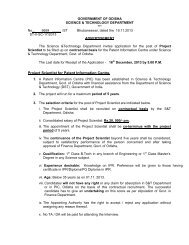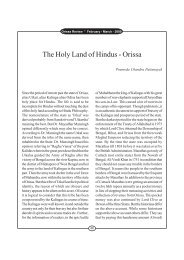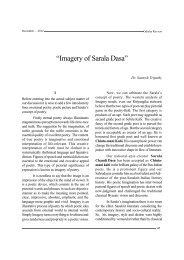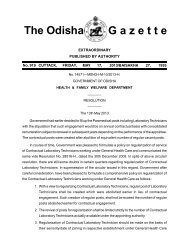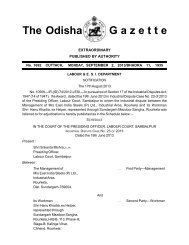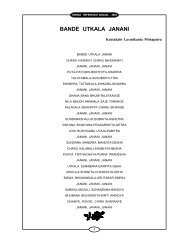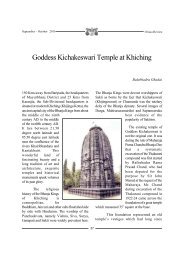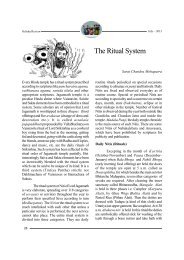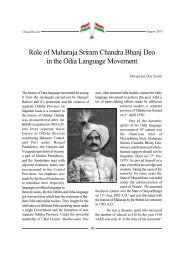You also want an ePaper? Increase the reach of your titles
YUMPU automatically turns print PDFs into web optimized ePapers that Google loves.
<strong>Dwadas</strong> <strong>Yatras</strong> <strong>of</strong> <strong>Sri</strong> <strong>Jagannath</strong><br />
(Twelve Festivals <strong>of</strong> the Lord)<br />
The temple <strong>of</strong> Lord <strong>Jagannath</strong> at Puri, a coastal<br />
town near Bay <strong>of</strong> Bengal popularly known<br />
"Mahodadhi", occupies a distinct place in the<br />
entire religious world. The word Puri has been<br />
derived from Purusottam Puri which is the<br />
fundamental and original essence <strong>of</strong> Hindu<br />
philosophy. Both temple and the Lords have deep<br />
impact on the social life <strong>of</strong> people. The social life<br />
<strong>of</strong> <strong>Sri</strong>khetra is more or<br />
less spiritual and<br />
cultural based. Amidst<br />
hundreds <strong>of</strong> rites and<br />
rituals and festivals in<br />
the <strong>Jagannath</strong> Temple<br />
during the whole year<br />
such as Snana Yatra,<br />
Hativesha, Anasar,<br />
Chakata Bhog, Pana<br />
Bhog, Fulurilagi, Osua<br />
and Khalilagi, Sandal<br />
paste <strong>of</strong>fering, Raja<br />
Prasad, Khali and Khadi prasad ceremony, Netro<br />
Utchhaba, Pahandi Bije, Rath Yatra, Sweeping<br />
or Chherapahara ceremony. Hera Panchami,<br />
Gundicha Rahas, Rath returned festival,<br />
Adharpana. Niladri Bije and sleeping Ekadasi,<br />
Garuda sleeping Ekadasi, Dakhinayan<br />
Bandapana, Chitalagi, Golden Pendant studded<br />
with diamond, sapphire, blue gem and blood-stone<br />
and emerald, Nrusing Yatra, Jhulan, Birthday <strong>of</strong><br />
Balabhadra, <strong>Sri</strong> Sudarsan's four Ashram journeys,<br />
Rahurekha ceremony, Birth day ceremony <strong>of</strong> <strong>Sri</strong><br />
Krishna, Nanda Utsav, feast <strong>of</strong> Jungle, plum selling<br />
54<br />
Orissa Review * July - 2005<br />
Banamali Suar<br />
ceremony, killing ceremony <strong>of</strong> demons (Asuras)<br />
i.e. Baka, Argha, Dhenuka, Pralamba, and<br />
Kekesi, Kaliyadalan, Mathurahato, Bastra Haran<br />
(stealing <strong>of</strong> sarees) Debagni, Nikunjalila blind<br />
game, Dahalila, killing <strong>of</strong> Kansa, birth day<br />
ceremony <strong>of</strong> Baban, Indradhwaja Puja, Indra<br />
Chandro Govind Elephant puja, Durga Madhab<br />
Yatra, gambling, Dasahara, Rajavesha, Weapon<br />
W o r s h i p ,<br />
Radhadamodar vesha.<br />
Hariutthan Ekadasi,<br />
Sarato Rahasa, Dipa<br />
<strong>of</strong>fering, Shradha, Pusa<br />
Abhishek, Makara<br />
and Dhanumuan<br />
Odana, Padmavesha,<br />
Fire ceremony and<br />
Dola Yatra, Ashoka<br />
Astami, Birthday<br />
ceremony <strong>of</strong><br />
Nrusingha and <strong>Sri</strong><br />
Rama and all his activities and plays from<br />
childhood to killing <strong>of</strong> Ravana, Akhyayatrutia and<br />
boating ceremony and marriage <strong>of</strong> Lord <strong>Jagannath</strong><br />
with mother Laxmi, only twelve festivals are<br />
considered to be most important. Those are<br />
observed one after another. Twelve months are<br />
fixed for twelve yatras. In the month <strong>of</strong> Jyestha,<br />
the marriage ceremony <strong>of</strong> <strong>Sri</strong> <strong>Jagannath</strong> takes<br />
place on Ekadasi day with Goddess Laxmi who<br />
writes a love letter expresing her desire for holy<br />
union with Lord. Then begins the ceremony and<br />
on fullmoon day, the grand bathing ceremony
Orissa Review * July - 2005<br />
starts on Snana Vedi. In Ganesh Vesha, the Lords<br />
appear very attractive and Anabasar day begins<br />
for fifteen days. In the month <strong>of</strong> Ashadha - Ratha<br />
and Bahuda <strong>Yatras</strong> are celebrated. This Yatra<br />
(festival) is the greatest and most important among<br />
all festivals. It attracts piligrims from all over the<br />
world. In Skanda Purana, the festival has been<br />
described as Mohavedi Mohoschhaba Yatra. It<br />
was the pious wish and order <strong>of</strong> Supreme God<br />
to king Indradyumna to arrange this festival in<br />
every year and to drive Him to holy land <strong>of</strong> <strong>Sri</strong><br />
Nrusingha. In three chariots namely Taladhwaja<br />
for God Balabhadra, Devidalana for Goddess<br />
Subhadra and Nandighosa for God <strong>Sri</strong> <strong>Jagannath</strong>,<br />
all deities are carried. In Devidalana, the Sudarsan<br />
wheel designed as a log <strong>of</strong> wood is seated on<br />
Her left side. The movable deities <strong>Sri</strong> Balaram<br />
and <strong>Sri</strong>krishna in Taladhwaja and <strong>Sri</strong><br />
Madanmohan dev in Nandighosa are also carried.<br />
All sects join in this festival. God <strong>Jagannath</strong> is<br />
Supreme Bramhan and Purusottama. The greatest<br />
psychic impact i.e. sense <strong>of</strong> unity, integrity and<br />
brotherhood bind all piligrims into one entity. The<br />
social life and spiritual life become one and same.<br />
After Bahuda Yatra, when deities are carried into<br />
the Temple in Pahandi, the last door closing<br />
ceremony is observed in inner sanction <strong>of</strong> the main<br />
Temple. The door opens by the order <strong>of</strong> Laxmi<br />
after getting satisfactory nine answers from <strong>Sri</strong><br />
<strong>Jagannath</strong>. In last answer, the social status and<br />
freedom <strong>of</strong> ladies are recognised by <strong>Sri</strong><br />
<strong>Jagannath</strong>.<br />
In the month <strong>of</strong> Shravan - the Golden<br />
Pendants, studded with diamond, sapphire,<br />
emerald, blood stone, and blue gem etc. are<br />
placed on foreheads <strong>of</strong> the deities. This is called<br />
Chitalagi and the birthday ceremony <strong>of</strong><br />
Balabhadra is also observed.<br />
In Bhadrava - birthday <strong>of</strong> <strong>Sri</strong>krishna is<br />
observed. The Yatra begins from birth till killing<br />
<strong>of</strong> Kansa Asura. During the entire period,<br />
Nandoatchhab, Kolibika, Kaliyadalan (Defeat <strong>of</strong><br />
55<br />
Blacksnake by <strong>Sri</strong>krishna), Killing <strong>of</strong> eight demons<br />
(generals <strong>of</strong> king Kansa), stealing game and<br />
Kansa's death etc. are observed for nineteen days.<br />
In these rites and rituals, the local inhabitants <strong>of</strong><br />
ancient streets (Sahis) take part directly. They<br />
use to hold meetings and decide democratically<br />
as to who will act as a demon. One person from<br />
each Sahi on each appointed day is dressed and<br />
decorated as a demon to display his game and<br />
lila as per custom and tradition. The movable<br />
representative deity <strong>of</strong> <strong>Sri</strong> <strong>Jagannath</strong> i.e. <strong>Sri</strong><br />
Madan Mohan after being permitted by Lord<br />
<strong>Jagannath</strong> takes part in this festival.<br />
In the month <strong>of</strong> Aswina - Durga puja<br />
festival is celebrated for sixteen days. <strong>Sri</strong> Madhab<br />
otherwise known Balapurusottam and Goddess<br />
Durga together get united for the entire period<br />
and Durgamadhab Rath Yatra is observed for nine<br />
days and golden Rajavesha is observed on<br />
Dasahara day.<br />
In the month <strong>of</strong> Kartika a special Bhog<br />
called Balabhog is <strong>of</strong>fered and different Veshas<br />
and decorations are made. Among those<br />
Radhadamodara vesha continues from Dasahara<br />
Ekadasi day to next tenth day. After newmoon<br />
till full moon on every monday Harihara vesha is<br />
observed for deity <strong>Sri</strong> Balabhadra. Harihara vesha<br />
make the Lord half black and half white. <strong>Sri</strong><br />
<strong>Jagannath</strong> is decorated and dressed in<br />
Laxminarayana vesha which begins from<br />
Dasahara Ekadasi day. On twelfth day Baman or<br />
Bankachuda vesha, on thirteenth day Tribikram<br />
or Dalikia vesha and on fourteenth day Laxmi<br />
Nrushingha vesha are performed and celebrated.<br />
In the month <strong>of</strong> Margasira - Dipa Dana<br />
ceremony and Pitrushradha are observed. A tree<br />
is artistically erected on the ground in inner sactum<br />
below Ratnasinghasan with sundried rice. After<br />
it is purified, ghee earthen lamps (dipa) are placed<br />
on different portions <strong>of</strong> said tree and then other<br />
customary rituals follow. The outer part <strong>of</strong> temple
is also lightened with earthen lamps (Dipa) and<br />
prayer is <strong>of</strong>fered to Almighty for restoration <strong>of</strong><br />
peace, security and prosperity <strong>of</strong> the King and<br />
his kingdom. In this month Ghodolagi begins. It<br />
means covering <strong>of</strong> body with clothes to protect<br />
from winter.<br />
In the month <strong>of</strong> Pausa, Pahilibhog<br />
ceremony is observed throughout the month. A<br />
special cake is prepared out <strong>of</strong> blackgram wheat<br />
flour and cow's ghee. On full moon day, the deities<br />
are decorated with Golden Rajavesha and<br />
coronation ceremony is also observed. On this<br />
day <strong>Sri</strong> Rama's coronation ceremony was<br />
celebrated at Ayodhya in the Ramayana days.<br />
In the month <strong>of</strong> Magha, Padma vesha and<br />
Gajauddharana vesha are performed.<br />
In Falguna the famous Dola festival <strong>of</strong> the<br />
Lords begins. After getting permission, <strong>Sri</strong><br />
Saraswati, <strong>Sri</strong> Laxmi, <strong>Sri</strong> Dolagovind and<br />
Madanmohan come to Dolavedi (alter) where the<br />
deities play with red colour powder i.e. called<br />
Fagu or Abira.<br />
In the month <strong>of</strong> Chaitra, the birthday<br />
ceremony <strong>of</strong> <strong>Sri</strong> Rama is observed. The movable<br />
representative deity <strong>Sri</strong> Rama after getting<br />
permission from <strong>Sri</strong> <strong>Jagannath</strong> takes part in such<br />
rites and rituals. All activities and plays from his<br />
childhood till killing <strong>of</strong> the demon king Ravan are<br />
customarily and traditionally observed. In this<br />
cultural yatra, there comes active participation<br />
<strong>of</strong> local inhabitants.<br />
In Baisakha begins the Chaitra Gundicha<br />
yatra i.e. Chandan Festival for 42 days. Out <strong>of</strong><br />
these days, only twentyone days are observed<br />
outside the temple in the sacred Narendra Tank.<br />
Two decorated boats are used for the boating<br />
ceremony. In the first boat, <strong>Sri</strong> Balaram and<br />
<strong>Sri</strong>krishna and five famous Sivas <strong>of</strong> <strong>Sri</strong>khetra such<br />
as Jameswar, Lokanath, Markandeswar,<br />
Kapalamochan and Nilakantheswar use to sit. In<br />
the second boat <strong>Sri</strong> Madanmohan Dev,<br />
56<br />
Orissa Review * July - 2005<br />
representative <strong>of</strong> <strong>Sri</strong> <strong>Jagannath</strong> alongwith mother<br />
Laxmi and Saraswati sits together. After boating<br />
<strong>of</strong> first phase, deities are carried to a small temple<br />
inside the Tank. Inside the temple, there is a small<br />
sweet scented water tank. Together <strong>Sri</strong><br />
Madanmohan, Laxmi and Saraswati use to have<br />
secret play and enjoyment for some hours. None<br />
is permitted to see this bathing ceremony. The<br />
doors remain closed under lock and key. Other<br />
deities use to take bath in different tanks openly.<br />
On the beginning day <strong>of</strong> boating ceremony,<br />
the Ratha preparation is being permitted by the<br />
Lords with performance <strong>of</strong> rites and rituals. Thus<br />
the above twelve festivals are observed for the<br />
Lords in twelve months. Harmony and balance<br />
have been maintained in all rites and rituals and in<br />
all festivals in order to establish a sense <strong>of</strong> unity<br />
among all castes, sects and religious faiths. Lord<br />
<strong>Jagannath</strong> is Purusottama. This has been well<br />
narrated in the first line <strong>of</strong> Bhismadeva's answer<br />
to the six questions <strong>of</strong> Judhisthira as mentioned in<br />
Visnusahasranama. He has been addressed as<br />
Atmayoni and Swayamjata which mean that<br />
Almighty Purusottama has no mother. He himself<br />
is the Creator and Destroyer, and Operator as<br />
mother. Thus he is both mother and father. He is<br />
both thesis and synthesis. The cultural values are<br />
unity, uniformity and universality. Lord Balabhadra<br />
and Goddess Subhadra are inseparable part <strong>of</strong><br />
<strong>Sri</strong> <strong>Jagannath</strong>. That is why He is the main presiding<br />
deity recognised and worshipped by all sects, and<br />
devotees <strong>of</strong> all religious faiths. His Bhoga<br />
mahaprasad is world famous. It has established<br />
socialism by derecognising the casteism, colour<br />
feeling and creed and special privilege. Nowhere<br />
in the religious arena ever exists such culture<br />
which is unique and incomparable.<br />
Banamali Suar is an Advocate who lives at Dolamandap<br />
Sahi, Puri. He is also a Sevayat in Lord <strong>Jagannath</strong> Temple,<br />
Puri.



